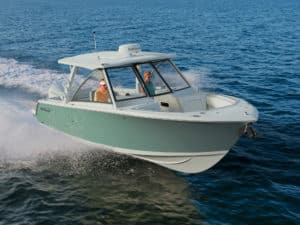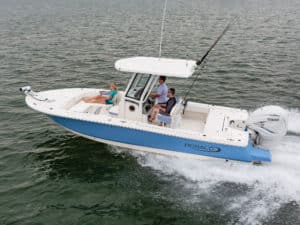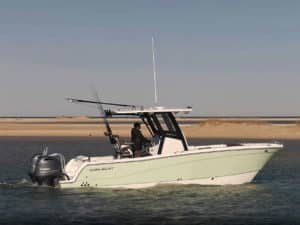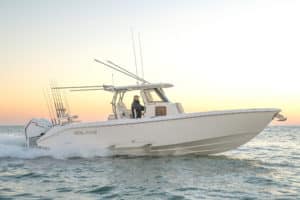When buying your first fishing boat, keep it simple. Modest expectations can make your ownership experience eminently more enjoyable. That’s what five of today’s top boat builders told us when we asked them what makes a good entry-level center console.
The other factor they championed: value. You can buy a cheap center console boat, but you’ll get cheap. Instead, aim to buy what you think is the best value center console boat. Value is where quality and price intersect. Small center console boats — 25 feet and under — often fit the bill as a good value.
Here’s how boat builders answered our questions about what makes the best beginner fishing boats. They also shared their most popular starter-boat models. (Boats are listed alphabetically by builder. Answers have been edited for space.) And if these boats don’t do it for you, check out our list of the best center console boats under 26 feet.
Boston Whaler 190 Montauk
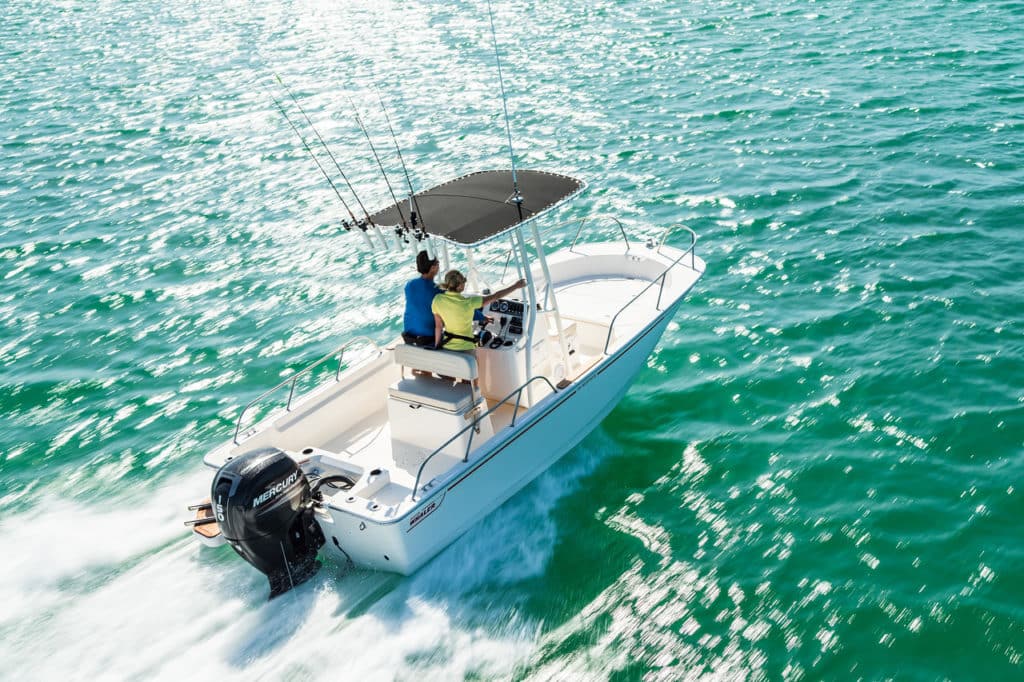
Q: What makes a good starter boat?
A: A good starter boat should be small and simple, assuming the customer does not have any boating experience. Most customers choose something between 13 and 20 feet as a starter boat.
Q: Who is the starter-boat buyer and what is he or she looking for?
A: New buyers are looking for a hassle-free boating experience with a simple boat to operate and maintain. They want low maintenance costs, and a boat that’s easy to operate, easy to trailer, and easy to load and unload.
Q: Why should a buyer consider your brand versus a cheaper intro model?
A: A Boston Whaler 190 Montauk is the perfect starter boat. It can carry seven people, which makes it perfect for a family of four that wants to take a couple of friends along with them.
It is easy to trailer and load. One person can do everything. It’s also easy to clean at the end of the day. We use the term “hose and go,” meaning it’s a very worry-free boat to clean.
Whalers have the highest resale value in the industry and will garnish the most on a resale or trade-in.
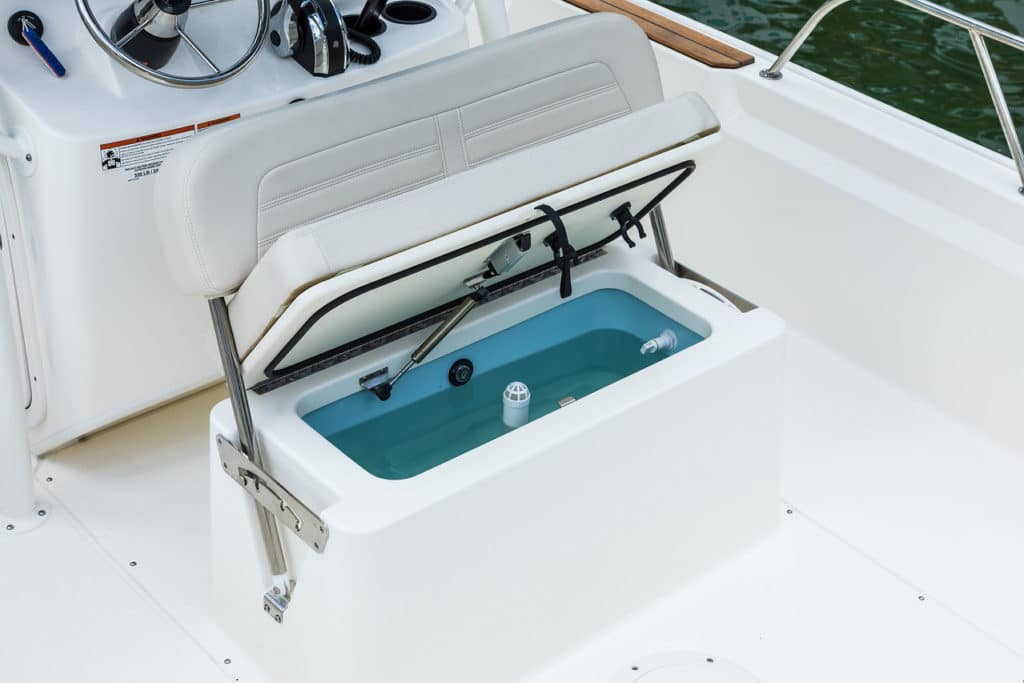
Q: What’s your best advice for first-time buyers?
A: Take your time in the purchase decision.
- Do your research.
- Make sure to test-drive each boat you’re considering.
- Compare factory warranties.
- Compare resale value.
- Don’t just purchase the cheapest boat.
Boston Whaler 190 Montauk Specifications
| LOA: | 19 ft. 4 in. |
|---|---|
| Beam: | 8 ft. |
| Transom Deadrise: | 16 deg. |
| Draft: | 1 ft. 2 in. |
| Dry Weight: | 2,000 lb. (w/o engine) |
| Max Power: | 150 hp |
| MSRP: | $46,080 (w/ Mercury 115/trailer) |
Cobia 220 CC
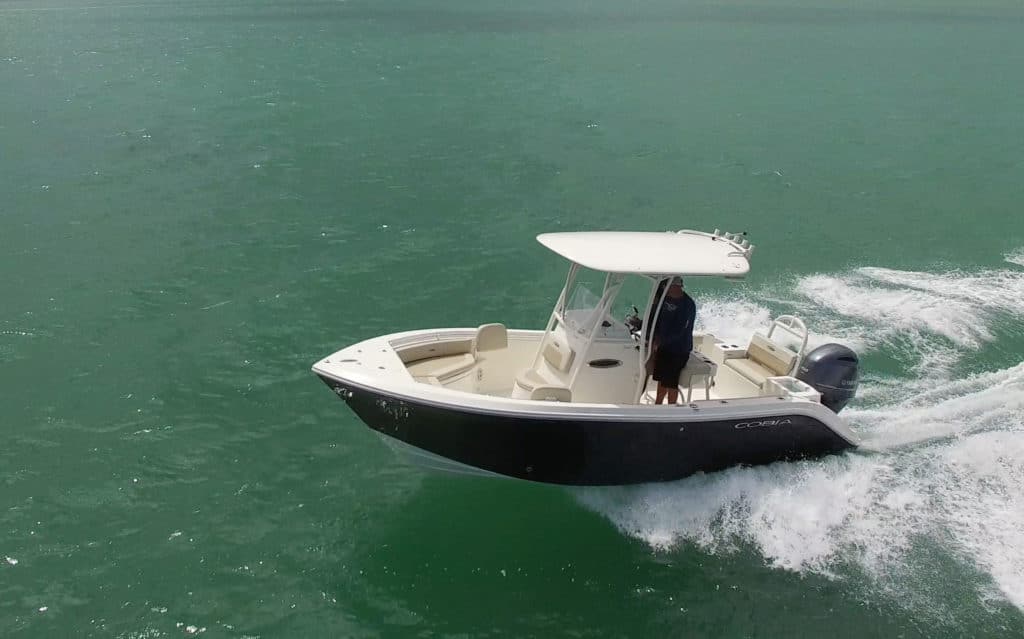
Q: What makes a good entry-level boat?
A: A good starter boat is easy to manage in terms of size and horsepower and easy to drive. Some higher performance boats require a lot of manipulation of the throttle, trim tabs and trim to get optimal performance and perfect balance. A good starter boat is well-balanced and runs smoothly and consistently with just a push of the throttle. Size is important because a smaller boat is easier to trailer, maneuver around the dock, clean and store. Don’t underestimate resale value, either. Cobia has great resale value for when you’re ready to move up.
Q: Who is the starter-boat buyer and what is he or she looking for?
A: A good rule of thumb is to pick a boat based on how you’ll be using it 90 percent of the time. However, because many new buyers might not be sure how they’ll use the boat, their first choice should be a boat that offers a lot of versatility. Size also typically plays a role because bigger boats can be intimidating in terms of trailering, docking and storing. In addition, smaller boats (24 feet and under) tend to be considered less of a financial risk, so they better align with first-time buyers who are testing the boating lifestyle to see if it’s right for them.

Q: Why should a buyer consider your brand versus a cheaper intro model?
A: How a boat runs and is designed dramatically impacts the owner’s enjoyment level. Often overlooked things like leaky dry storage compartments, bad layouts that make simple tasks more difficult than they need to be, and overall poor construction can make using a boat more of a hassle than enjoyment. Cobia is known for being a quality, well-designed boat and a trusted brand that offers great customer service.
Q: What’s your best advice for first-time buyers?
A: Keep it simple and do your research. There’s a reason why you find a fleet of Cobia’s smaller CC and DC models at boat rental clubs up and down the coast — they are the perfect starter boat! But don’t take our word for it. Join the Cobia Owners’ Group on Facebook and ask them why they picked Cobia. There are lots of owners in the group who have already spent time going through the same process and will be more than happy to tell you anything you want to know.
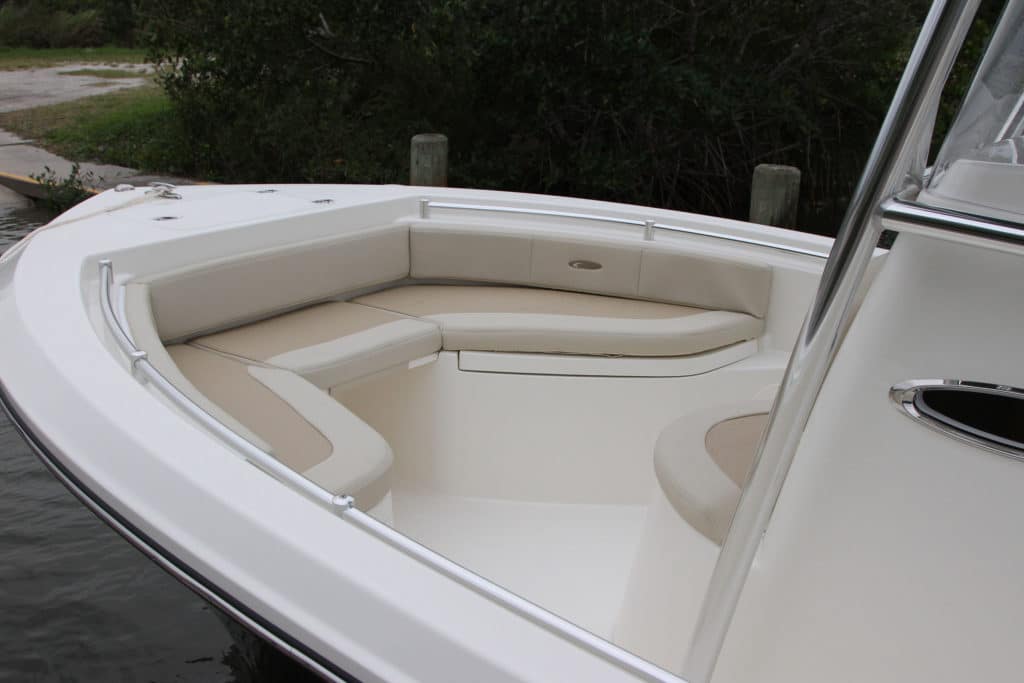
Cobia 220 CC Specifications
| LOA: | 21 ft. 7 in. |
|---|---|
| Beam: | 8 ft. 6 in. |
| Transom Deadrise: | 20 deg. |
| Draft: | 1 ft. 6 in. |
| Dry Weight: | 3,460 lb. (w/ engine) |
| Max Power: | 250 hp |
| MSRP: | $56,210 (w/ Yamaha F150XB) |
Contender 25 Tournament

Q: What makes a good starter boat?
A: A starter boat needs to be a package that allows owners to learn about boating without introducing them to too many options. With that said, buyers should have a few choices so they can experience different technologies and buy a boat that fits their needs and style.
An entry-level center console boat would be in the low- to mid-20-foot range with a single or twin outboards. It should offer family-friendly amenities, and be versatile enough to accommodate several boating activities. It should be easy to trailer and store, and not be overly expensive to maintain and operate.
Q: Who is the starter-boat buyer and what is he or she looking for?
A: Starter-boat buyers have been on the water with friends or family. More often than not, they’re educated about certain aspects of boats, but might not be fully aware of the boat-buying process. They usually want a boat that is as close to turnkey as possible, though with some choices available so they can make it their own.

Q: Why should a buyer consider your brand versus a cheaper intro model?
A: When purchasing a small center console boat, it’s really important to take quality into mind. There are plenty of boats that you could get for less money, but what is your experience with those boats going to be like?
If things are constantly breaking, the boat beats you up, your friends and family are uncomfortable on it, you’re unable to use it in less than optimal conditions, or it doesn’t perform several functions well, your experience is going to be a negative one, and you’re less likely to want to continue boating.
Q: What’s your best advice for first-time buyers?
A: Take your time. Get opinions from a variety of people who use different products, systems and boats and who fish like you do.
Use boat shows to your advantage and look at everything that might fit your size and price range. Let the sales staff know you’re looking for a starter boat, and ask them as many questions as you can. Narrow your search and compare boats head to head. Make sure to sea-trial each boat to gauge handling, ride and performance.
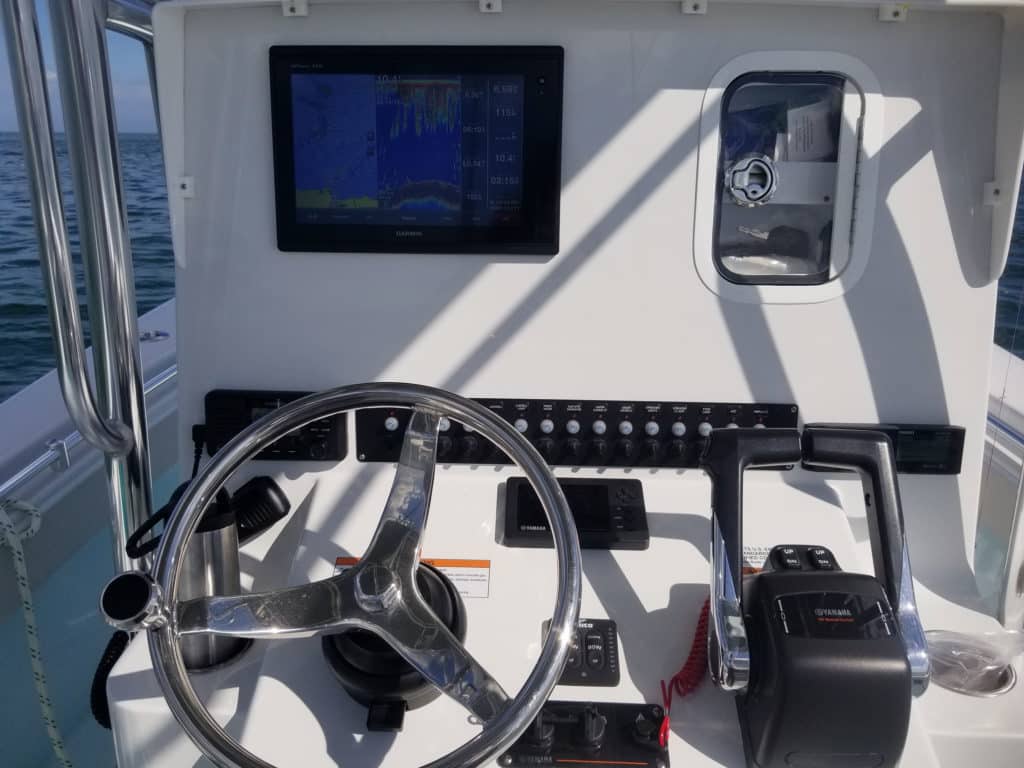
Contender 25T Specifications
| LOA: | 25 ft. 3 in. |
|---|---|
| Beam: | 8 ft. 6 in. |
| Transom Deadrise: | 24.5 deg. |
| Draft: | 1 ft. 6 in. |
| Dry Weight: | 6,250 lb. (ready to fish) |
| Max Power: | 400 hp (single or twin configurations) |
| MSRP: | $120,681 (w/ twin mechanical Yamaha F150s) |
Grady-White Fisherman 216
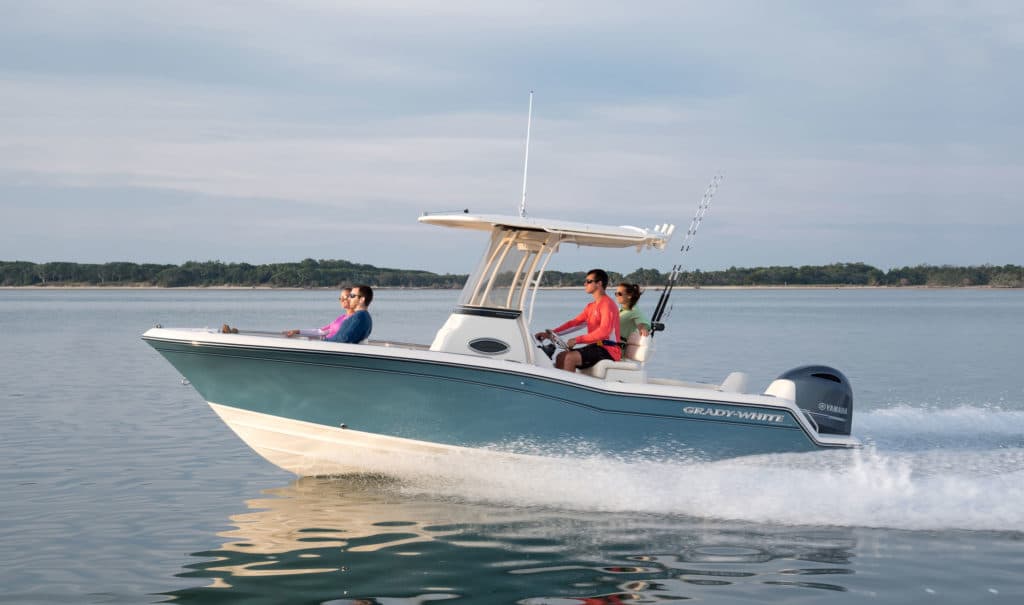
Q: What makes a good starter boat?
A: It’s very important that a great starter boat be safe and easy to operate. It should offer a terrific ride and quality construction, be reliable, and require low maintenance. Selecting a boat that is NMMA certified means it has met all of today’s safety standards in its construction.
To choose a good starter boat, new buyers should think clearly about the type of boating and fishing they’ll be doing and how many people will join the fun. Most people want a boat that does more than one thing well.
Another important buying aspect is the boat dealer—an experienced dealer is especially important for a brand new boater. Dealers can set up boat-handling sessions, provide how-to information for fishing, offer events to introduce new boaters to the area, and more. Many of Grady-White’s dealers also have Grady-White Owners’ Clubs and can introduce new boaters to this terrific resource and support system. A strong dealer will help a new boater get a great start and keep their boat and engine preventative maintenance up to date to ensure they have many happy years of boating ahead.
Q: Who is the starter-boat buyer and what is he or she looking for?
A: After the strange months of COVID-19, boating became a wonderful outlet for many people who had not boated before. Everyone seemed to be in search of quality time together, somewhere other than home—somewhere safe. Being outdoors, having fun together with friends and family and multi-generational combinations are what we’ve seen. All these new boat buyers want a vessel that can do many things, is safe, seaworthy, easy to handle and drive, and is even easier to clean up at the end of the day.
That’s why it’s so important to find a small center console that has many well-thought-out features already built in. Things like a cooler, a livewell, rod holders, ample storage areas, and even a head compartment to make sure everyone is comfortable all day on the boat.
They need a true self-bailing cockpit and boxes that drain overboard, instead of into the bilge, to make cleanup simple and quick. They also want a boat with a strong, sturdy feel, which handles well and is fun to drive.
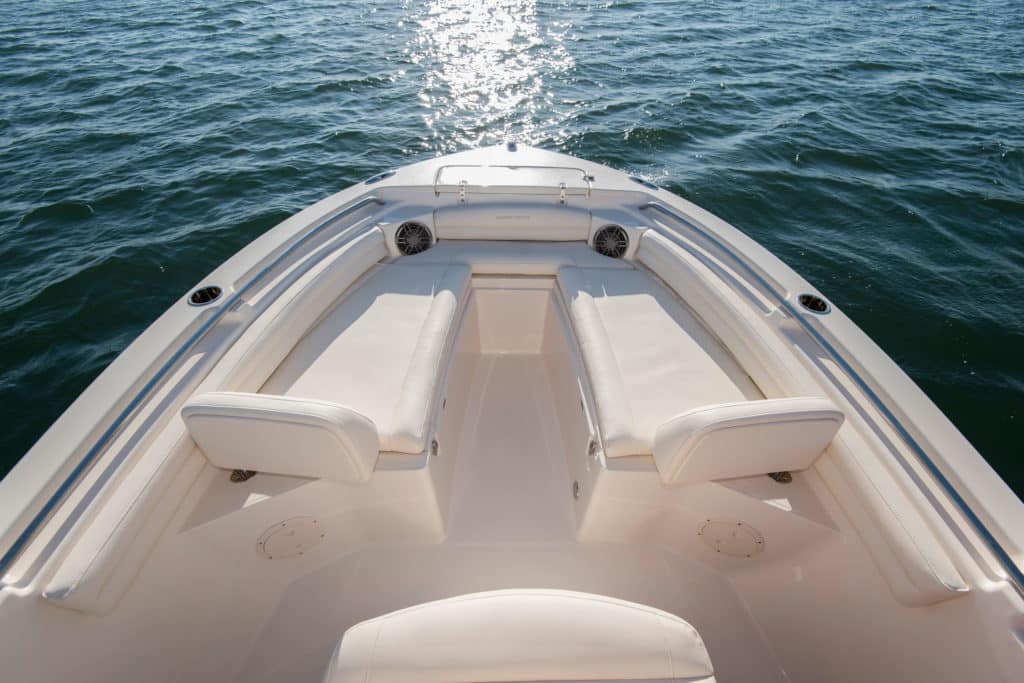
Q: Why should a buyer consider your brand versus a cheaper intro model?
A: Grady-White has spent countless hours perfecting its products: from superb engineering to the best parts and materials available in the industry to highly-trained and passionate craftspeople that create the most exceptional details in every boat we build. First, our trademark SeaV2 hulls give you a smooth, stable, dry, comfortable and efficient ride even on days when other boats would not be able to go out. Second, our unsinkable foam flotation, true self-bailing cockpits and overboard draining boxes add a high measure of safety and easy cleanup.
Not only will our carefully chosen high-quality, long-lasting materials mean low maintenance, they’ll save you time and make you money too. When you decide you want to trade up to a bigger boat, like a center console over 25 feet, Grady-White boats consistently have higher resale value than most other brands. At Grady-White, our goal is for every customer to have a legendary boating experience, so staying in touch with our customers and making sure we are exceeding their expectations is a huge part of the value equation when you own a Grady-White boat.
Q: What’s your best advice for first-time buyers?
A: Boating is an investment of time and money, so it’s important to research and buy the boat that will give you the most enjoyable time on the water. Talk to folks who have boated for a long time, and they will tell you it’s better to spend a little more up front to have less trouble while you own your boat. They will also say “make sure you take a demo ride on a day when weather is less than ideal.”
Get to know your local dealer; he or she can support you as you learn more about boating. A long-term, great dealer will be there to help you transition to your next boat, and so will we, just like we have for over 60 years.
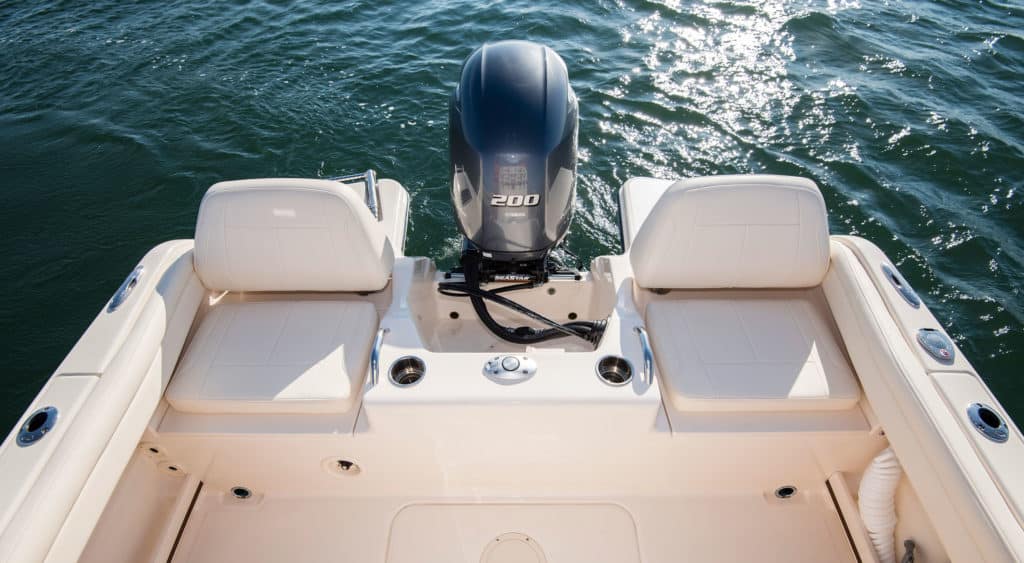
Grady-White Fisherman 216 Specifications
| LOA: | 23 ft. 3 in. |
|---|---|
| Beam: | 8 ft. 6 in. |
| Transom Deadrise: | 19 deg. |
| Draft: | 1 ft. 4 in. |
| Dry Weight: | 3,125 lb. (w/o engine) |
| Max Power: | 250 hp |
| MSRP: | $87,600 (w/ mechanical Yamaha F200) |
Scout 175 Sportfish

Q: What makes a good starter boat?
A: Anything in the 17- to 21-foot range.
Q: Who is the starter-boat buyer and what is he or she looking for?
A: Starter-boat buyers are looking for something safe to get them and their families out on the water. They want a boat that is fuel-efficient, easy to drive and handle, and easy to trailer and possibly store in a garage. Low maintenance and low cost of ownership are also important.
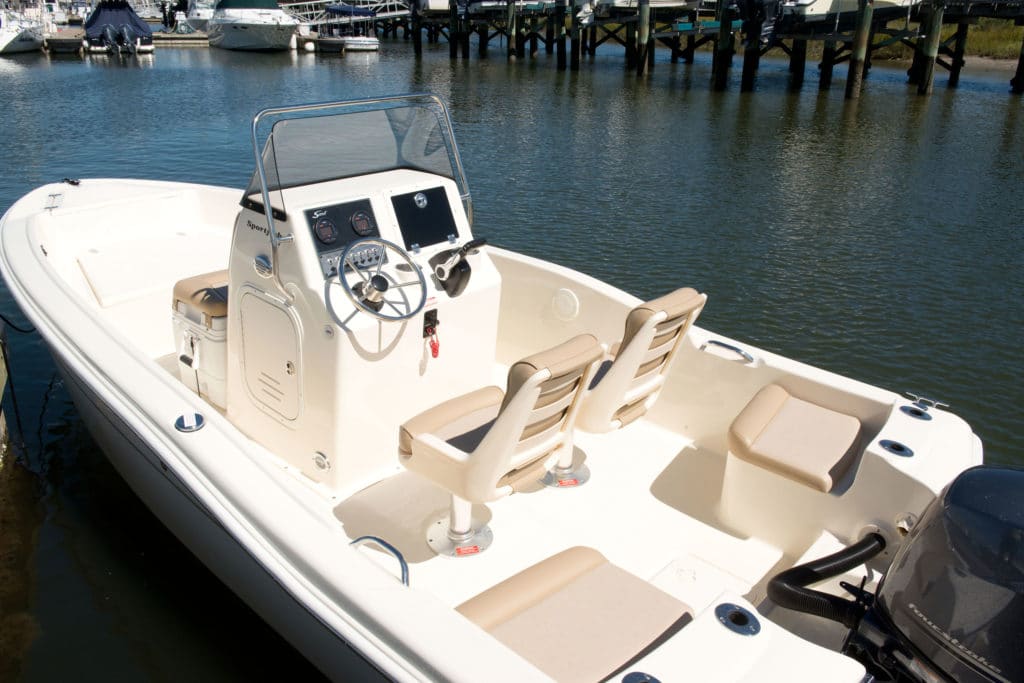
Q: Why should a buyer consider your brand versus a cheaper intro model?
A: Scout Boats has a three-year limited stem‑to-stern warranty. Our fuel economy is second to none, and we use the same build methodology in our small vessels as we do in our larger boats. Fit and finish are second to none. Scouts also have a quality reputation, they’re unsinkable, and they offer incredible resale value.
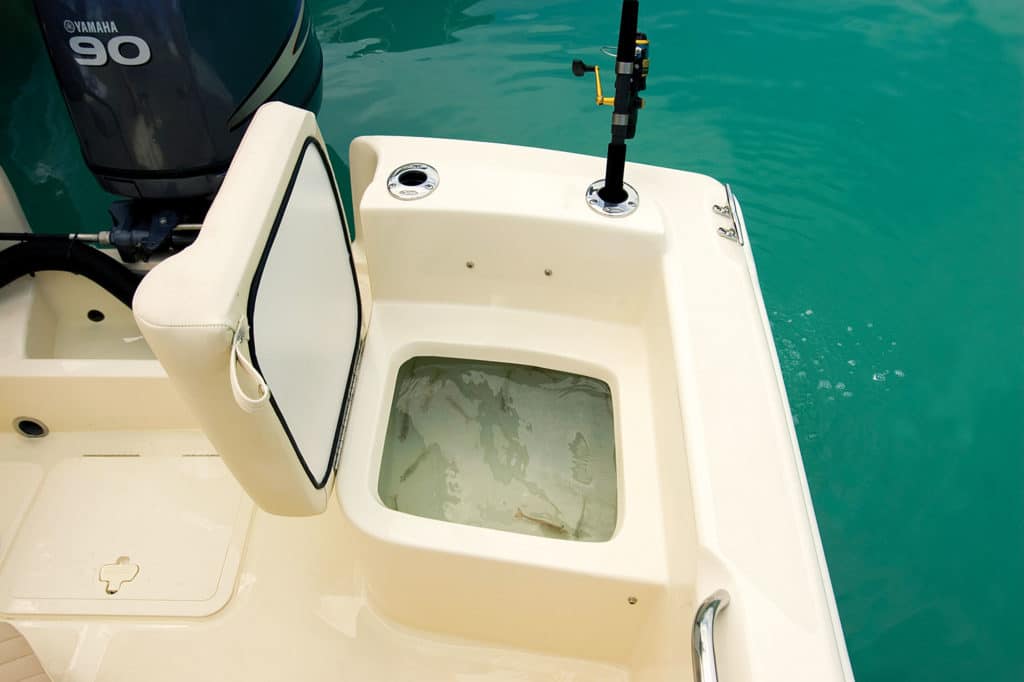
Q: What’s your best advice for first-time buyers?
A: Buy a boat that you’ll be proud of, backed by the best warranty. Look at the overall cost of ownership and resale value. You get what you pay for. Don’t just go for the cheapest price tag.
Scout 175 Sportfish Specifications
| LOA: | 17 ft. 5 in. |
|---|---|
| Beam: | 7 ft. 5 in. |
| Transom Deadrise: | 13 deg. |
| Draft: | 10 in. |
| Dry Weight: | 1,260 lb. |
| Max Power: | 115 hp |
| MSRP: | $34,776 (w/ Yamaha F90LB) |

